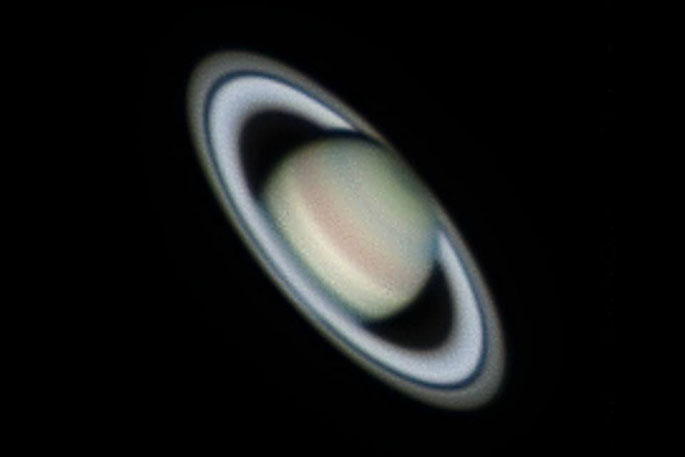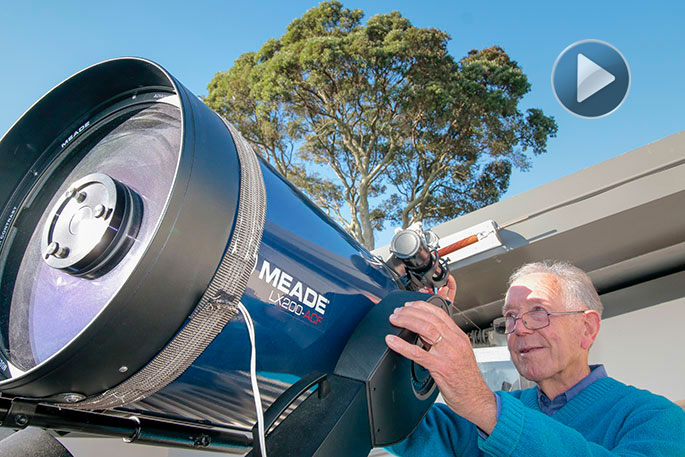Last night at the Tauranga Observatory, telescopes were focused on a rare array of planets.
All the planets in our own solar system are now on the same side of the solar system, which means they are all currently visible in the night time sky.
There was barely any cloud over Tauranga last night, which ensured great viewing of the planets as well as the craters on the Moon.
The observatory houses a variety of equipment including a 14 inch Meade LX200-ACF telescope, a Lundt Solar 60 telescope for viewing the Sun, a 10 inch Dobsonian, a 8 inch Meade LX10 SCT and a couple of other smaller telescopes.

Archer Bays, age 10, Robert Bays, and Stuart Murray at the Tauranga Observatory. Photo: Bruce Barnard.
During the evening, people queued to view Jupiter, the rings of Saturn and the Moon through the scopes. Venus and Mars are very bright in the sky at the moment, Venus in the early evening in the Western sky and Mars later in the evening in the Eastern sky.
The Tauranga Astronomical Society is located in the northeast corner of the community complex at Ferguson Park in Matua. Meetings are held on the second and fourth Tuesday of every month at 7:30 pm from February through to December.
At the meetings, presentations are given on current astronomical topics and the club holds telescope viewing, weather permitting.
Last night Dr George Gray continued his series of talks on the planets of our solar system with a presentation on Mars. It was highly interesting, informative and interactive, covering the history of life on Mars and the three mass-extinction events that Mars has experienced. A quiz was interspersed during his presentation using the Kahoot mobile phone app. First prize in the quiz was a Mars bar.
'I usually come along and sit in the audience,” says George. 'But Stuart does so much with organising the presentations. I try and help out by finding a good documentary that lines with what's in the sky, and put some questions into it, so that people will have an active learning experience.
'They can come along, learn from a high quality documentary about a topic, and then go to the telescope and actually see it. So it's a combination of theoretical and practical, relevant to what's present in the sky at the moment.”

Out on the deck at night viewing the planets of the solar system through the telescopes. Photo: Rosalie Liddle Crawford.
The video ‘Mars – Life & Death on the Red Planet' was shown as part of the ‘How the Universe Works‘ series. Mars is particularly close right now, as it makes its closest approach to Earth since 2003. It will be a ‘mere' 36 million miles from Earth this week, according to NASA, before both planets travel away from each other as they orbit the sun. Mars's reddish, orange colour is easily seen in the eastern evening sky, and western morning sky just before sunrise, nearly as bright as an airplane landing light.
Mercury takes 88 days to orbit the Sun so it will be back on the other side within weeks, but the planets further out take much longer. Jupiter and Saturn will be on the same side for years. Jupiter takes just under 12 years to orbit the Sun, and Saturn takes about 29 and a half years so they move a lot slower.
Six months from now, we will be on the other side of the Sun from where we are now, almost 300 million km away. Our orbital speed around the sun is about 107,000 km per hour.
Robert Bays and his son Archer Bays age 10 joined the club about a year ago.
'Archer got really interested and got a telescope,” says Robert. 'We then Googled and found the Tauranga observatory and ever since it's been a lot of fun. We go to every meeting.”
Archer has an eight-inch Dobsonion telescope at home, and attends Greenpark School.
'I like coming here because it documents space and I find the subject very interesting,” says Archer, who takes his own telescope out onto the deck at home.
'I've seen Mars, Jupiter, Saturn, Venus and some star clusters.”
'I love the documentaries we show at the club,” says Robert. 'And also the viewing, and showing people Jupiter and the planets. Seeing them amazed when they see it for the first time is enjoyable.”
Some of the telescopes at the observatory are very portable, and can track the planets, making them easy to use.
The club keeps the meeting topics relevant and current.
'We initially started with DVDs and programmes going back to Apollo missions,” says club member Stuart Murray. 'Now we try and keep the programme as topical as we can. The last few decades science and astronomy have grown astronomically. Each fortnight there's something new happening.
'The technology is advancing and allowing us to see further and do things. It's changing as new ideas and philosophies creep in.”
Upstairs at the observatory is the pride and joy of the club, a 14 inch Meade LX200-ACF telescope, which I'm told is the second best telescope in the country, imported from the USA. The base under the telescope is separate from the building, so that vibrations won't affect it. With the push of a button, the roof slides back on the observatory and the night sky becomes visible.
The lights from the port and the training lights on the sports fields around the observatory don't help with viewing, but the club members feel that if the observatory was located ‘up in the hills' then there wouldn't be the high public turnout to view the stars.
Les Smith took up an interest in astronomy on retiring, about 17 years ago. He lives nearby and has taken school groups through the observatory as well as taking telescopes out to visit children in kindergartens.
'It's very interesting as there's so much happening,” says Les. 'With the new telescopes you can look at space from different frequencies.”
I came away from the club night marvelling at the thought that I'd just seen Saturn, 1.3 billion km away from where I was standing in Otumoetai. Later this week NASA will be releasing new images of Mars taken by the Hubble Space Telescope, coinciding with the planet's close approach to Earth.
Tauranga Astronomical Society club members are looking forward to the lunar eclipse taking place on the morning of Saturday July 28. At 7.17am, the eclipse will reach its greatest magnitude while the entire Moon is above the horizon in Tauranga. The true maximum point of this eclipse cannot be seen in Tauranga because the Moon is below the horizon at that time. Since the Moon is near the horizon at this time, going to a high point or finding an unobstructed area with free sight to West-southwest will provide the best view of the eclipse.
 Tauranga Astronomical Society club night at the Tauranga Observatory. Photo: Rosalie Liddle Crawford.
Tauranga Astronomical Society club night at the Tauranga Observatory. Photo: Rosalie Liddle Crawford.
 The Moon. Photo: Tauranga Astronomical Society.
The Moon. Photo: Tauranga Astronomical Society.
 Saturn. Photo: Tauranga Astronomical Society.
Saturn. Photo: Tauranga Astronomical Society.



0 comments
Leave a Comment
You must be logged in to make a comment.